David McFall R.A. (1919 - 1988)
Sculptor
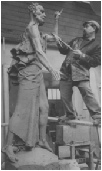
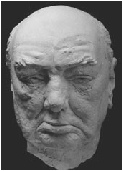
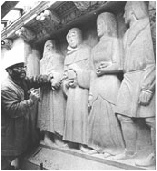
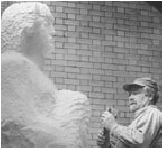

1958/2 The Rt. Hon. Sir Winston S. Churchill K.G. O.M. C.H. M.P.
Head study ("The Rocquebrune Head")
Bronze (cast by Fiorini foundry). Height 12"
Exhibited Royal Academy Summer Exhibition 1958 Catalogue No. 1410
Royal Academy Summer Exhibition Illustrated Magazine 1958 page 91
McFall had been commissioned to produce a statue of Churchill for Woodford Green [see 1959/4]. On 28/1/1958 he travelled to the south of France where Churchill was staying with friends, Emery and Wendy Reves, at Villa La Pausa, Rocquebrune to undertake a first head study for the statue. When he arrived he found Churchill ill in bed, and it later transpired that he had suffered his first stroke, which is visible in the drooping mouth of this study. The first sitting was on 3/2/1958, the second on 4/2/1958, the third on 5/2/1958 and the fourth and last on 6/2/1958. McFall then plaster moulded the clay in his hotel room and left to return to London on 11/2/1958 where he cast the plaster on 13/2/1958.
References:
1) "His portrait of Churchill is so incomparably the best ever done of him that it is astonishing that it is not on permanent public display (Peter Greenham CBE, RA, PPRBA, Keeper of the Royal Academy letter 17/2/1983)".

2) David Carritt 12/5/1958: [headline] "A petty rule has robbed the Tate of this" [reference to Chantrey bequest rules which it breached by being modelled in France] "If any exhibit in this year's Royal Academy should be bought for the nation, surely it is David McFall's bronze head of Sir Winston Churchill. The President of the Royal Academy, Sir Charles Wheeler, thinks so. So does the Director of the Tate Gallery Sir John Rothenstein. So do such austere judges as Professor Gowing and Sir William Coldstream... It is sad that the Tate should be deprived of this moving portrait.
3) Daily Herald 31/3/1958: "Look at the sculpted head of Churchill... we have seen
Churchill stubborn, Churchill grave, Churchill triumphant - but surely this is Churchill
the man of sorrow. The promising Scots sculptor David McFall confirmed my view yesterday.
The man who has been commissioned by Churchill's constituents in Woodford Essex
to produce a 9ft statue of the Grand Old Man told me: "When I went to Roquebrune
to sculpt him, just before his illness, I was struck by something in him I had not
expected to see. Tragedy. His age is a matter of great sorrow to him, and I have
caught him at a very tragic moment of his life. I felt I had to do this intimate,
unhappy head of him. I shall not use this head for the statue. The statue will
be of a legend. But this is just the head of a man. In his glory - and disappointment".
McFall will take his strange sad head of Churchill to the Royal Academy today, where
it will be shown in this year's exhibition. How did McFall catch that look on his
face ? "I know he doesn't like pompous, self-important artists, so I made myself
as invisible as possible" said the sculptor. "I put him on an ordinary chair instead
of a rostrum, which meant that I had to work on my knees. And I used the minimum
equipment. By persuading him that I was hardly there at all, I ca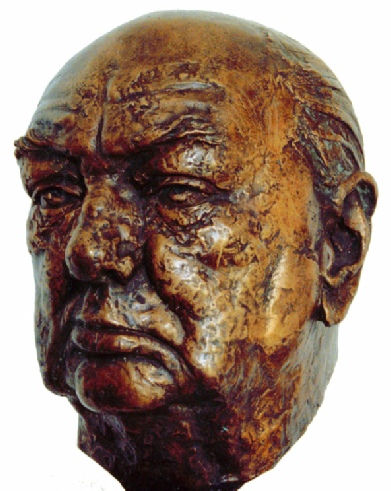 ught the private,
instead of public, expression."
ught the private,
instead of public, expression."
4) Glasgow Herald 8/3/1958;
5) The Observer 4/5/1958 (with photo)
6) Letter 4/3/1958 from Wendy Reves, Villa Pausa, to David McFall: "...Of course I am thrilled that you have been given the commission as who could do it better ... I have spoken a great deal about you to Lady Churchill ... I showed Lady Churchill your letter and she's very anxious to know you and will, on her return to London, make a point to meet you and discuss your work with you. She has made an interesting point, dear David, and that is she would greatly prefer a 'seated statue'. Her first reason is that to put the face of Sir Winston of today onto a body of Sir Winston during the war days would, of course, be most peculiar looking and, if the entire statue is done after the manner of him today - then it should be seated. Also she feels that Roosevelt's statue (standing) is very unattractive and fears the results might be similar ! She's very interested indeed in your statue-to-be and I feel she will be a great help to you. I pass on these thoughts of hers on the subject as she wished me to do so ! In any case you will soon be meeting her and she will tell it all to you in person - but, she does have reason in saying this - don't you think ? Of course, you can realize how frantic we have all been over Sir Winston's illness - but thank the dear God above ... he has come out of it and seems even more fit than before (as yet we have not taken him "out" but before the week is over I'm sure he'll be back into his normal pattern of life ..."
7) Letter 20/3/1958 from Wendy Reves, Villa Pausa, to David McFall: "...Our great man has had a slight relapse - nothing serious but it was necessary for him to go again to his bed for several days. Poor lamb - he is very discouraged. I believe it will take some time for him to regain his strength as the medicines were strong and weakening - alas ! ... Lady Churchill will remain here until his return but greatly looks forward to meeting you upon her return... I found the (photo of) the plaster Churchill most imposing and powerful ... the eyes too closed is my only criticism but then I know - as you explained - you wanted to capture him as you saw him and, indeed, he was rather sleepy during those days. We now know that it was the beginning of his illness - and his health was not at its best when you were here ! I am so happy that you came when you did as it may be a very long time before he can undertake a "sitting" again..."
8) John Keatley writes 8/5/1993: "...McFall told him that the Churchill family did not like the Roquebrune head (it was after his stroke and this is obvious from the distortion in his mouth). They persuaded him to do another head which, while less accurate, was more flattering" [the Chartwell bust – see 1958/7].
All rights reserved

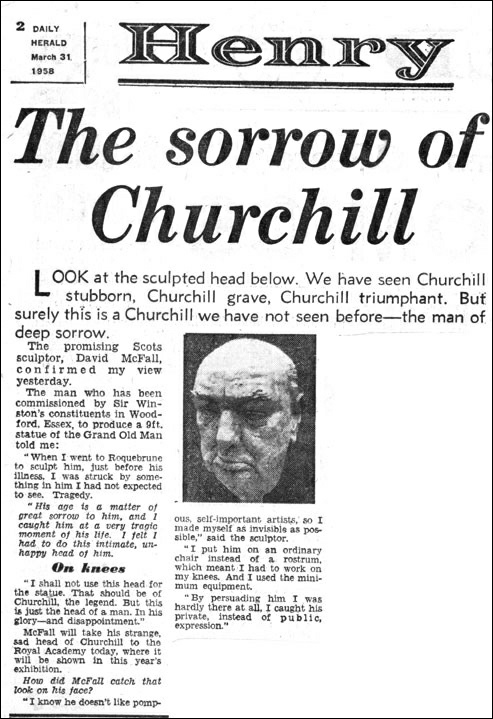
| Animals |
| Busts and Heads |
| Children |
| Churchill studies |
| Lettering |
| Medals coins plates |
| Reliefs |
| Stone carvings |
| Contemporary British Artists |
| On Epstein |
| Picasso |
| The art of portrait sculpture |
| Letters |
| Palliser |
| Son of Man |
| Press |
| Obituaries |
| Memorial address |